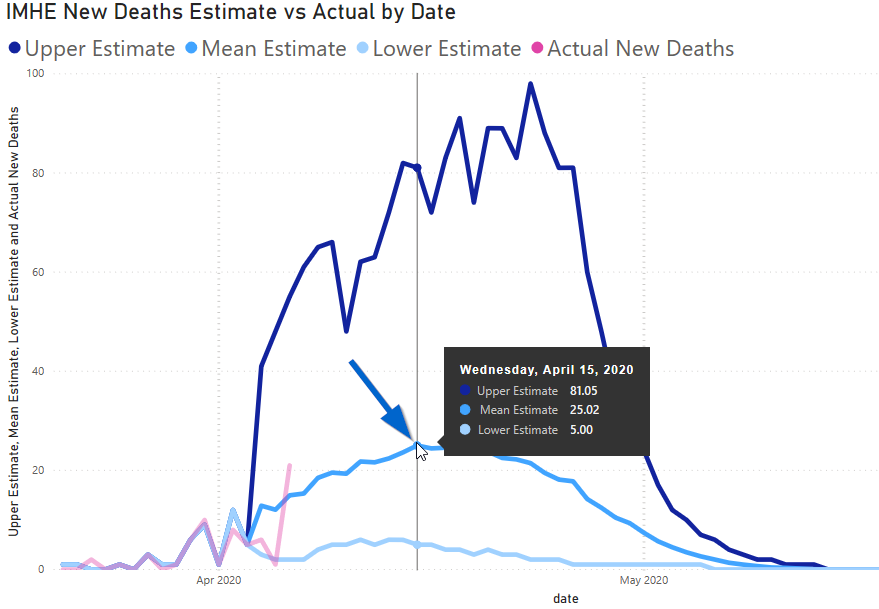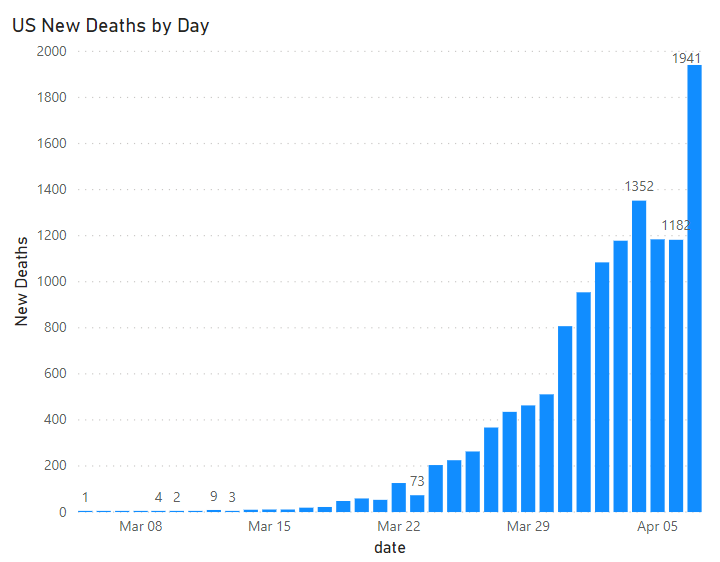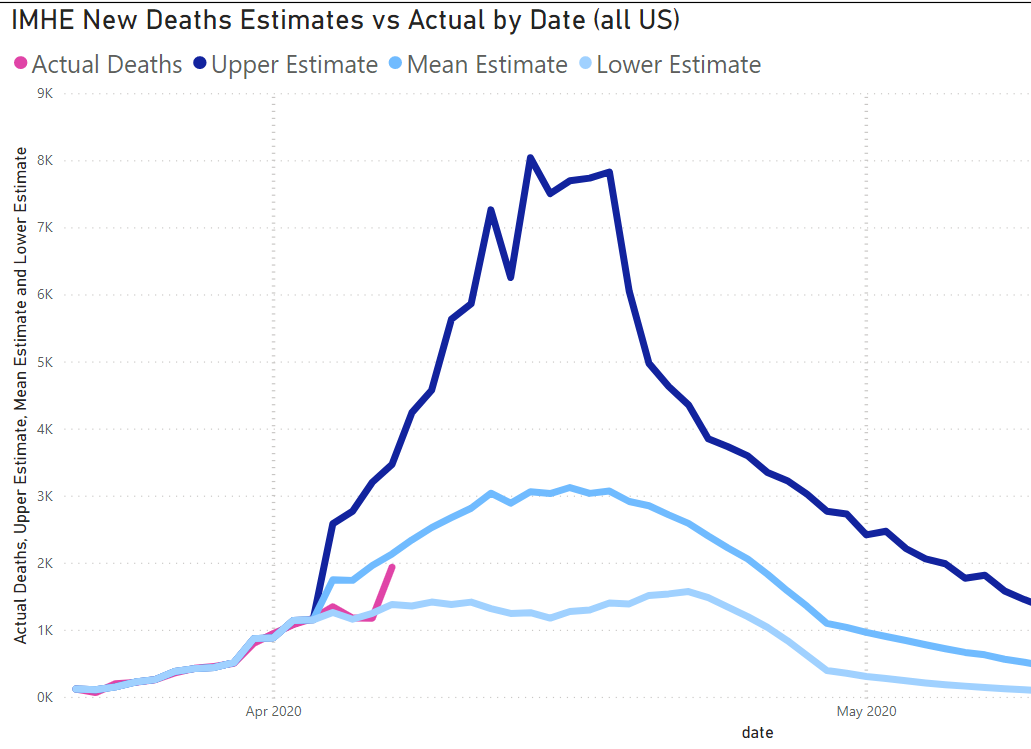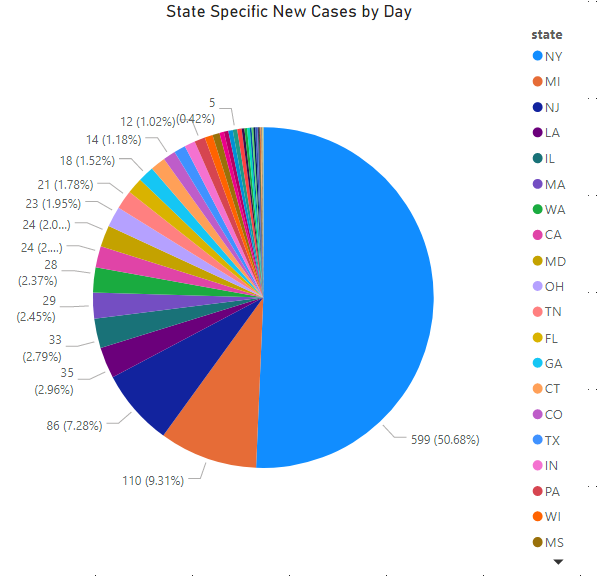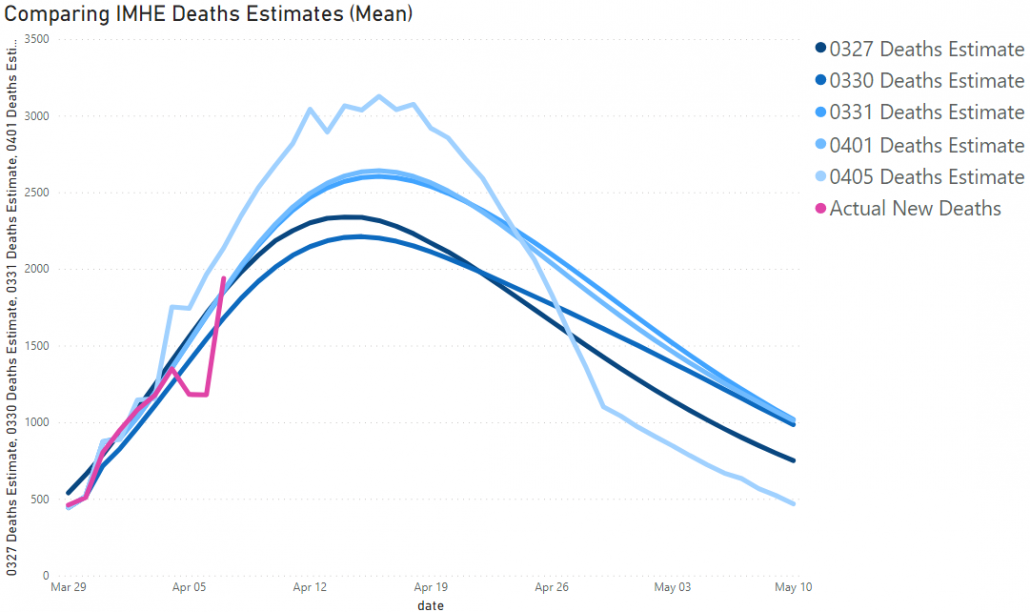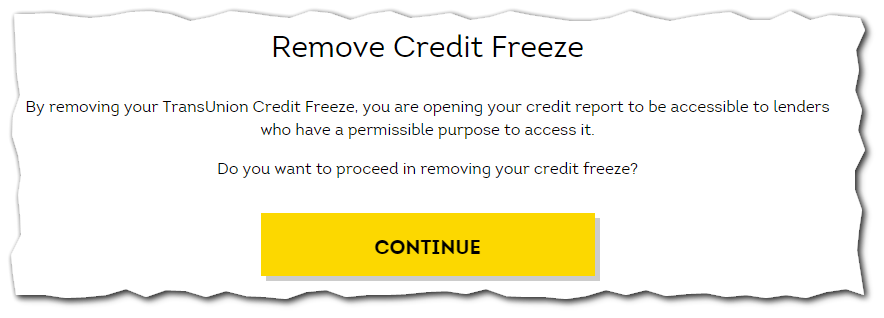We’re working on putting together an interactive report so you can jump into this data on your own.
If you want to preview this interactive report and give us feedback please email Jonathan.addington@jmaddington.com
Tennessee: One Week Left of Stay-at-Home. Maybe.
Bill Lee’s Executive Orders 22 and 23 are keeping many Tennesseans home and businesses closed. April 14th is the last day that they are in effect and so far Goveneror Lee has indicated that he doesn’t plan to extend the orders. On the day he signed executive order 22 (March 30th) Tennessee reported 297 new cases of COVID-19 and 6 new deaths resulting from COVID-19.
Since that time we’ve seen cases increase from 1,834 to 4,138 and deaths from 13 to 72. Governor Lee also cited what we believe are the same projections we have been tracking, updated versions showing Tennessee with fewer deaths than previous projections.
The expiration of those orders, however, also comes at the peak projected date for COVID-19 in Tennessee.
Our continued belief is that the virus will drive timelines not the will of policymakers. With 366 new cases in Tennessee today, it will the third largest increase since March 31st. If new cases drop back down to pre-March 30th levels we may see those orders expire. However, it will be a difficult position for Lee to defend if deaths and new cases are still above the level of when he originally put the order in place.
This issue is a hot topic in Tennessee because only six of the states 95 counties have the authority to issue stay-home-orders themselves (Davidson, Hamilton, Knox, Madison, Shelby and Sullivan). Even counties with cases higher than Knox county (Williamson, Sumner, Rutherford) can’t independently make people stay home, they rely on the state government to do so.
But it Doesn’t Matter
(The following departs from our data-driven reporting. It is, however, the way we view the next months unfolding and represent how we will plan)
However, we don’t believe that the legalities will be a driver of when Tennesseans — or Americans more broadly — get back to work. First, the stay-at-home orders define essential businesses very broadly. There are 16 industries defined at the federal level with over a hundred examples of essential businesses [1]. Second, it is hard to imagine the public broadly returning to life as normal so long as COVID-19 is a perceived threat.
It is going to take 18-24 months to have COVID-19 under control. All of the social distancing that we have and are doing is to throw up a defensive wall against it. Bring the wall down and we let the virus back in. To effectively combat it we need either herd immunity (let most people get it) or a vaccine. We believe that successful organizations are going to plan for three distinct stages and implement them regardless of the legal environment.
Stage One: Lockdown. This is where we are today. The strategies employed are to maintain cash, preserve future options and for most businesses stay active however possible. This portion is likely to last a total of six weeks to twelve weeks. (So, for East Tennesse, this ends early May to early June).
Stage Two: A Partial Return. At this point, new cases per day and deaths per day will be back down to pre-pandemic levels, around where they were in early to mid-March in most of the United States. However, COVID-19 will still be circulating in the community and the public will be well aware of it. “Flu-like,” symptoms will send workers home for two weeks or until they test negative for COVID-19. A positive test in the workplace, religious institution, daycare and other organizations is likely to shut the physical place down for a few days up to a couple of weeks. Exposed staff, customers, congregants, etc., will be asked to self-isolate for two weeks or until they test negative for COVID-19.
The strategies employed during this period will two-fold. First, organizations will need to figure out how to mitigate risk:
- Manufacturers may split staff in extra shifts so a case in one shift doesn’t close down the entire operation
- Organizations may have employees work in “pods” to limit potential exposure
- Retail stores may continue to limit physical store capacity
- Companies may split employees between “work from home” and “work at the office” in rotating week-long shifts
- Travel will be limited to necessary meetings only
- There will be more video calls and phone calls than before COVID-19
- Companies with high-risk employees or employees with high-risk family members may need to move into a low-exposure role
- Churches, non-profits, after-school care will need to figure out how to reduce physical capacity while maintaining overall capacity
- Companies with close working quarters will need to put up physical sneeze guards, clean more often, etc.
- Companies may implement temperature checks at the door for employees and visitors alike
Underlying the above will be the understanding that an outbreak in a community (neighborhood, city, county) will still have the potential to send that community back into lockdown to get the outbreak under control.
Second, successful organizations will figure out how to serve a new set of needs:
- Online services for churches are going to be with us for a long time, as high-risk congregants can’t go out
- Curbside delivery, family meal packages from restaurants, etc., may become a new standard
- Organizations will equip employees to safely interact with high-risk populations (house cleaning for grandma, grocery delivery, etc.)
- Organizations may need to rely on flexible “work from home” policies to retain key staff that are high-risk or have high-risk family members
- Cleaning services can offer deep-clean disinfection on a regular schedule
- Multiple industries will need to set aside service hours — or days — for high-risk populations (salons, barbers, grocery stores, restaurants, movie theaters)
- Supply chains will continue to be different than they were pre-COVID-19 as some industries are up (consumer TP) and others are down (hotels)
There are no doubt many more needs that your industry will need to consider. You need to begin the planning process now for how you meet new needs while mitigating infectious risk at the same time.
The timeline for this partial return is 18-24 months and will likely be interrupted, but by locality and industry, and for shorter time periods than Stage 1.
Stage Three: A New Normal. At some point, we’ll have a working vaccine or herd immunity. At that point, there will be the potential for a “return to old normal.” Organizations that thrive at this point will come in two stripes: (1) those that will completely forgo the risk mitigations (and hence, costs) associated in dealing with COVID-19, and (2) those that will accurately measure their exposure to future risks as well as the public perception around it.
In the first group will be entrepreneurs who either don’t care or didn’t have to steer a ship through this current crisis. Because risk mitigation mitigates profits as well, there will be some of these. However, they will be in the minority.
Of the second set, organizations are going to have to know what strategies employed in Stage 2 are still effective, either from a customer perspective or an actual risk-mitigation perspective. At what point can grocery stores or restaurants go back to full capacity without endangering patrons? When do churches encourage all congregants to come back to Sunday services? You can’t just be guessing at this. Organizations that thrive will spend the next year setting objective milestones that determine when a particular strategy has become more hurtful than helpful.
This second set will also continue to plan for the next outbreak. We’ve all learned a lot in just a few short weeks. Early notice and preparation make all the difference. A flexible workforce can keep you going when the government shuts your office down. Cash cash cash cash. N-95 masks and hand sanitizer don’t go out of style. At a deeper level, these organizations will continue to have objective benchmarks that alert them when they need to pick a strategy back up again.
They will be ready to jump back into Stage Two, or Stage One for COVID-23 or whatever comes next.
They will have clear communications to staff, customers and vendors about what will trigger them to act, how, and when.
Stage Three won’t end. It will be our new normal.
Today, you should be spending as much time planning for Stage 2 as navigating through Stage 1.
Financial News
The Treasury Department is already working to get another $200 billion to fund small business loans. This week First Horizon Bank began taking applications, we’ve heard that Pinnacle and Smart Bank already had applications open. United Community Bank wrote in an email to customers:
…”at this time, the U.S. SBA has not released the SBA note to the banking community. We hope to receive that today, April 7, 2020, but will not fund approved loans until we have received the note from the SBA.”
United Community Bank
We only know a single business that has had their EIDL approved, but funds have not yet been received.
PPP Compensation Cap: There have been mixed messages whether the $100,000 cap was limited to compensation (pay) or total costs (pay+taxes+benefits). The Treasury’s official guidance is, “The $100,000 salary limitation does not include healthcare, retirement benefits, and state and local taxes.” Thanks to Mitch Reed (CPA) for sending that over.
Where Are We?
A week out from the peak there were a lot of deaths today in the US as a whole.
New York State makes up half of those deaths. Tennessee is 11th on the list, although at 21 deaths to 599 it doesn’t seem comparable.
The Knox Area new cases chart (missing today’s data) still shows us close to where we want to be. Obviously see this go down would be better, however, it is reminiscent of Italy’s chart where there was a week of plateau before a clear down-trend.
Our hope is that we are at the beginning of that plateau here. It certainly is a more manageable number of cases than many other places around the country, or even the state. By comparison, Davidson County alone has over 800 cases.
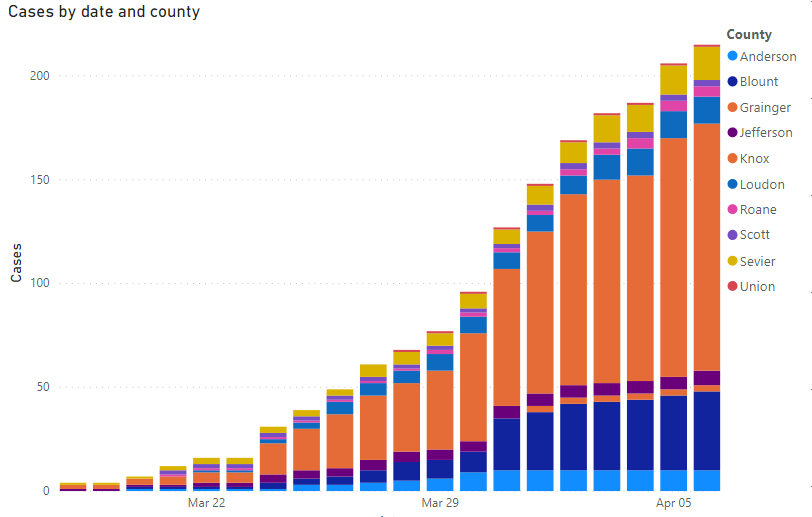
Estimates Trend
If we compare the IMHE various estimates we can see that their middle estimate is actually trending upward more quickly in the short term and then dropping more quickly as well. An upside-down V is how they are starting to shape out.
These models assume that social distancing occurs beyond April 14th.
How JM Addington is Adjusting
Today we did something we never thought we would do and permanently lifted our credit freezes at all three major credit unions. Typically, these freezes are the best thing you can do to keep someone from stealing your financial identity. They can also stand in the way of getting financing.
We’ll turn them back on but it may be a few months.
We’re increasing cash on hand in the business and personally, and consolidating them at a single institution to make it easier to get credit going forward. Our personal taxes are in and we’re taking the refund instead of applying it to 2020 taxes.
Get In Touch
Need help thinking this through? Access to more data? Help getting your technology in order to handle what’s here and what’s coming? Contact us today.
Other
Thanks to those that have shared kind words or liked these posts. We’re doing out best to put out data-driven analysis, each one of these takes about 2 hours. It’s helpful to know that they are being read.
If you want copies of the Excel sheet and PowerBI Reports we use to put these together email us, info@jmaddington.com. Right now, our PowerBI combines data from JHU, NYT, COVID Tracking Project, IMHE and the TN Department of Health. Most sets are updated daily.
[1] Executive Order 22 references this CISA guidance.
Download our Report!
Get your copy of What Every Business Owner Must Know About Hiring an Honest, Competent, Responsive, and Fairly-Priced Computer Consultant.


